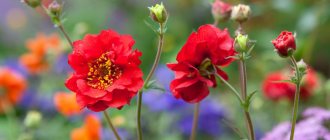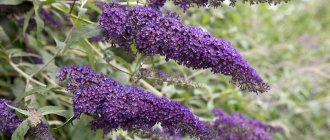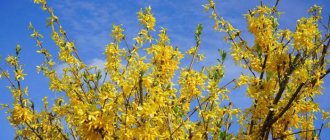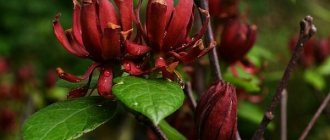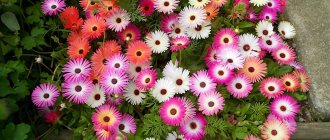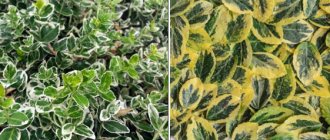Author: Natalya Category: Garden plants Published: January 20, 2019Republished: February 21, 2019Last edits: January 13, 2021
- White ageratum
Ageratum bushes with small fluffy flowers of the most delicate lilac-blue, white or pink color are not called long-flowered for nothing: you can admire their modest beauty from the beginning of summer until frost. Ageratum is called ageless because in its natural habitat this perennial does not change appearance even with changing seasons, but in our gardens it is grown as an annual crop: the plant does not tolerate frost.
In the article about ageratum you will find the following information:
- how to grow seedlings and transplant them into open ground;
- how to care for the plant during the season;
- how to protect ageratum from diseases and pests.
Planting and caring for ageratum
- Planting: sowing seedlings - in the second half of March, followed by transplanting the seedlings into the ground in the second ten days of May.
- Flowering: from June until the first frost.
- Lighting: bright sunlight.
- Soil: light, nutritious, not too greasy, neutral.
- Watering: abundant, at the root.
- Feeding: once every three weeks alternately with organic and mineral fertilizers. Applying fresh manure is strictly not recommended.
- Reproduction: cuttings and seeds.
- Pests: leaf and root-knot nematodes, cutworm caterpillars, spider mites, whiteflies.
- Diseases: root rot, bacterial wilt, cucumber mosaic virus.
Read more about growing ageratum below.
The plant ageratum (lat. Ageratum) belongs to the genus of the Asteraceae family. Its representatives are found mainly in North and Central America, as well as in Eastern India. The name of the plant comes from the Latin ageratos, which means “ageless,” and in fact, ageratum remains fresh for a very long time when cut. In Europe, ageratum became widespread in the 19th century; in our country it is called “long-flowered”. It is grown in gardens for its fluffy flowers, similar to pompoms, collected in dense inflorescences, most often in a blue palette of shades; in addition, it is completely unpretentious in care. There are about 60 species of ageratum.
When to sow ageratum for seedlings?
Sowing is carried out from mid-March to mid-April in small containers.
The composition is a mixture of peat, sand and humus taken in equal proportions.
Previously, the substrate is abundantly moistened with a spray bottle and seeds are sown on the surface. The seed material is distributed evenly over the surface, and a 2-3 mm layer of substrate is sprinkled on top.
Then the container is covered with plastic film (a glass jar) or placed in a mini greenhouse, creating greenhouse conditions. It is necessary to maintain 20-22 degrees.
Place the container in a well-lit place without direct sunlight.
The container is regularly ventilated and the soil moisture is monitored, and if necessary, lightly moistened with a spray bottle.
After 1-2 weeks, the first shoots will appear, and upon reaching two of their own leaves, the young shoots dive into separate containers. By this time, the seedlings will have become stronger and do not need a greenhouse.
The second time, each seedling is planted into separate bowls. As soon as the night frosts recede and warm days arrive, ageratum is planted in open areas, as a rule, this happens from mid-May.
Botanical description
Ageratum is a small bush with triangular, oval or diamond-shaped leaves of a lush green color with a serrated edge. The upper leaves are alternate, sessile, and the middle and lower leaves are opposite, on petioles. Numerous erect, pubescent stems reach a height of 10 cm to 60 cm. The flowers are small, fragrant, bisexual, collected in small inflorescences-baskets from one to one and a half centimeters in diameter, which in turn form complex corymbose inflorescences - they are not only blue and purple, but also white and pink shades. The fruit of Ageratum is an elongated wedge-shaped pentagonal achene.
- Bergenia: planting and care in the garden, types and varieties
One gram contains approximately 7 thousand small seeds that remain viable for 3-4 years.
In our climatic conditions, ageratum is grown as an annual plant, since it is very thermophilic. Ageratum looks great in a flowerbed, in a garden bed, and is used to create carpet compositions. Plant partners of ageratum include other annuals - snapdragons, marigolds, calendula.
In the photo: Flowering ageratum
Growing ageratum from seeds
Sowing seeds
Ageratum is usually propagated by seed. Ageratum seeds are sown in the second half of March in boxes with soil consisting of equal parts of humus, sand and peat. Small seeds are carefully sprinkled on top with the same soil and covered with glass or film. You need to keep the greenhouse in a room where the temperature is not lower than 15 ºC, and ventilate it daily.
It is very important to keep the soil slightly moist at all times, so be sure to sprinkle the soil as it dries.
The seedlings usually germinate in a couple of weeks, and from the moment they appear, the box can no longer be covered with glass or film.
Growing seedlings
After the seedlings have two pairs of true leaves, they need to be planted more spaciously. Ageratum seedlings need to be picked twice, and during the second picking, each sprout should be planted in a separate pot or cup. The air around the seedlings should be dry and the soil moist. Watering ageratum is carried out only in the morning. Two weeks before planting, move the plants outdoors to acclimatize, but if there is a threat of frost, be prepared to cover them.
- Daffodil flowers
Reproduction
Ageratums reproduce by seeds and cuttings. Plants propagated by cuttings begin to bloom in early May, and by seeds in mid-June. The long-flowered plant is characterized by a long growing season, so it is necessary to sow it as early as possible; it takes more than 2 months to prepare the seedlings.
Timing of sowing seeds
Ageratum is grown mainly from seeds, which are sown in special boxes or containers in mid-February - early March. The sowing date may be delayed until April, but then flowering will begin in the second half of summer.
Work order
- The soil used is a special substrate for sowing seeds, available in garden stores. You can make the soil yourself by mixing the same proportion of sand, peat and garden soil.
- Ageratum seeds for seedlings are sown on the surface of the soil, then covered with a thin layer of sand or fine soil. You can simply gently push the seeds into the soil, since germination requires light.
- After wetting the soil, the boxes (boxes) with the sown seeds are covered with film or glass.
- Crops are kept at home, in a warm room with enough light. The main condition for growing ageratum seedlings is constantly moist soil, thanks to which the seedlings grow faster. It is also important to provide illumination for seedlings, especially when sowing in winter, when daylight hours are short. For ageratum seedlings, choose a warm, sunny window sill of a south window. The first seedlings will appear (depending on conditions) about a week after sowing the seeds.
- Picking seedlings. After several true leaves appear, the seedlings can be planted (transplanted) into large pots. When picking, the tip of the root is cut off, due to which the root system of the seedling grows better and stronger. Behind the third pair of leaves, it is also worth pinching the top of the main shoot and side shoots, which will lead to better branching of the plants.
Photo. Seedlings after picking
- Hardening of seedlings. Before transplanting ageratum into open ground, the seedlings are hardened off. Plants are gradually accustomed to the conditions prevailing outside, for example, by ventilating the room with seedlings or taking them outside for several hours a day, gradually increasing the hardening time.
Ageratum can be sown in the ground (or balcony boxes) only after the spring frosts have passed. You can plant 2-3 plants in one pot. It is better that the air temperature is 15-20 degrees.
It is worth taking care of the appropriate distance between plants, which will allow them to grow properly. The distance between long-flowered flowers should be 10 × 15 or 15 × 20 centimeters.
Sowing rate in open ground: 5-7 seeds per 1 m² of soil.
Propagation by cuttings
Propagation by cuttings is beneficial only when it is possible to obtain some interesting variety. Ageratums propagated by cuttings are usually weaker, although more even.
Mother plants are planted in pots at the end of August. The soil is made up of perlite and deoxidized peat. Plants should be stored in winter in a well-ventilated area with a temperature of 10-14 degrees. Some plants will die, but from mid-January, cuttings from the tops of shoots 5-8 cm long are taken from others, which are planted in a mixture of peat and sand. It is recommended to heat the substrate from the bottom, maintain moderate humidity (spraying it periodically with water) and shade.
Ageratum seedlings rot quite easily, so when watering, make sure that the drainage works and excess water drains away.
The seedlings take root quite quickly. After the seedlings have grown, they are transplanted one plant at a time into pots.
Planting ageratum
Ageratum is planted in the ground when night frosts are left behind. Choose a site that is protected from drafts and brightly illuminated by the sun - if you plant ageratum in the shade, the shoots will begin to stretch, and instead of compact bushes you will have disheveled bushes that bloom haphazardly. The soil is preferably well-drained, nutritious, light and not acidic, but ageratum is not capricious in this matter. Before planting, thoroughly loosen the soil, dig holes at a distance of 10-15 cm from each other and plant the seedlings at the same depth at which they grew in seedling boxes or pots. The ageratum will bloom in about two months.
In the photo: Ageratum in the garden
Ageratum care
Caring for ageratum involves watering, fertilizing, loosening the soil and weeding. Ageratum should be watered abundantly, but not excessively; after watering, remove weeds while loosening the soil. Feed the plant with humic or mineral fertilizers every two to three weeks. Fertilizing with mullein infusion has a good effect on ageratum, but under no circumstances use fresh manure as fertilizer - ageratum does not tolerate it.
How to grow cineraria - proven tips
Try not to overfeed the plant, otherwise it will turn lush and not bloom. Remove faded inflorescences in a timely manner. If you want the ageratum to bloom profusely and beautifully, you should trim it as necessary, leaving only a few internodes on the stem. Usually, after such pruning, ageratum grows quickly and blooms more luxuriantly.
Description of ageratum
Ageratum bushes are compact and low-growing. They are dotted with fluffy flowers, very similar to pompoms, and the leaves come in the form of a diamond, oval or triangle. Luxurious colors and low maintenance are some of the main advantages of the flower. There are about 60 plant species. In mid-latitudes it is grown as an annual due to its instability to low temperatures.
Ageratum after flowering
On the eve of the first frost, transplant the most beautiful ageratum bushes into flower pots and bring them into the house, onto the balcony or veranda - they will decorate your home until the end of autumn, and maybe even in winter. In March, you can take cuttings from these bushes and root them so that you can plant them in the garden after frost.
In the photo: Ageratum begins to bloom
In general, ageratum is a heat-loving plant that cannot tolerate even the mildest winters. Hiding won't help him either. Therefore, you will have to clear the flowerbed of the remains of ageratum and plant new plants next spring.
Ageratum in landscape design
Ageratum is universal for creating unsurpassed flower arrangements. Due to the multi-colored flowering, purchased seeds are often found mixed with different colors; after sowing, multi-colored carpet paths and borders are obtained.
A frequent guest in the composition when creating alpine slides, flower beds, tall varieties act as hedges, they create multi-colored carpet paths, blue varieties create an imitation of a stream flowing in the wind.
Ageratum is used in compositions with calendula, phlox, salvia, snapdragon, etc.
Low-growing varieties are used to decorate gazebos; they are placed in a suspended state on balconies, loggias, around gazebos and verandas.
Diseases and pests
The weakest point of ageratum is its susceptibility to disease. Most often, ageratums suffer from root rot, and there is no escape from this disease. But by taking preventive measures, namely, choosing light soil for planting ageratum, controlling watering and regularly loosening the soil to slow down the process of evaporation of moisture from the soil, you can prevent the disease. Ageratum is affected by cucumber mosaic and bacterial wilt, and all this is a consequence of improper plant care.
- Doronicum: growing in open ground, types
I will repeat my mantra: diseases and pests attack plants when you violate the rules of caring for them for a long time. If you strictly follow the rules of agricultural technology, your plants will not be afraid of such troubles.
Protect young plants while they are at home or in the greenhouse from spider mites and whiteflies, but if they appear, you will have to remove damaged leaves and treat the plants with insecticides until the insects die. Later, in the flowerbed, cutworms and nematodes may encroach on the ageratum, and you will have to work hard to get rid of them.
Pests and diseases
The ageratum flower is prone to damage by various diseases and harmful insects
The following may appear:
- root rot
- gray rot
- bacterial wilt
- cucumber mosaic
Diseases do not arise only with proper care.
If we talk about harmful insects, then there are:
- whiteflies
- aphid
- spider mites
- scoops
- nematoids
For prevention, it is advisable to treat the plant with insecticides.
Let us consider in detail what to do if the plant becomes infected or is struck by this or that insect:
Root rot
Root rot
Blackleg or root rot often appears. Main symptoms of the disease:
- wilting of the plant
- drying out of foliage
- the occurrence of constrictions
- color change
- appearance of brown spots
- growth slowdown
If this happens, nothing will help. The plant will have to be removed, and the soil that is also contaminated will be removed. To prevent this disease, care should be taken to keep the soil light and avoid waterlogging.
In addition, systematic loosening is required. Thanks to these manipulations, the appearance of rot is minimized.
Gray rot
Among the most dangerous plant diseases caused by fungi of the genus Botritis is gray rot. Spores are spread by wind, also by contact (with the gardener’s hands, through tools) while caring for ageratum, on the legs of insects, by droplets of water (rain or during watering). The disease is activated when there is humidity.
Dark spots on the foliage indicate damage to the plant.
In the future, a grayish coating will appear - this is the appearance of spore-bearing mycelium. At the first signs of disease, it is necessary to immediately treat all plantings with fungicides.
It is advisable to purchase:
- Fundazol
- Topaz
- Bordeaux mixture
If the situation changes for the worse, all affected individuals should be removed. You can't leave them. It is recommended to burn immediately.
Bacterial wilt
In the southern regions, plants may also suffer from this disease. At the same time, the foliage cracks, the moisture evaporates from them, and the turgor decreases.
Yellow spots appear, they have a brown border
When cut, it is clear that the choroid plexuses have darkened. As a result, sap flow is impaired. As a result, the plant dies.
To cure a flower, you need to treat it with Coronet. It's important to start this right away. If you miss time, it is not possible to save the ageratum.
If you use wilting-resistant varieties, you don’t have to worry about infection.
Cucumber mosaic
The virus is transmitted by sucking harmful insects. After infection, white or yellow spots appear on the foliage. It is impossible to eradicate the disease as it progresses, but it can be prevented.
Cucumber mosaic
It is important to weed the beds on time, plant healthy planting material and control pests.
Aphid
The size of the insect is small.
It ranges from 0.3 to 0.8 mm. The shape depends on the type of aphid. It can be elliptical, ovoid, teardrop-shaped, etc. The color is the same as that of the plant on which it parasitizes.
To get rid of aphids, flowers are sprayed with a special solution. You can prepare it yourself.
To do this take:
- garlic cloves (200 g)
- water (1 l)
The first ingredient needs to be crushed. This is done using a grater or meat grinder. Then the resulting slurry is filled with water. The resulting solution must be infused for five days.
After the required time, the infusion is diluted with additional water. Here you should adhere to the following proportions: 300ml/10l.
Spider mite
Body in the shape of an ellipse, covered with hair
The back is convex. Larvae have six legs, adults have eight. The feet have nails, which are what they use to cling to the plant. The color of young individuals is light green, but with age it darkens and becomes brownish. They reproduce by laying eggs.
Spider mites can be removed by treating with insectoacaricides.
These drugs are in the form of:
- Agraverina
- Neorona
- Nissorana
Whitefly
Whitefly
This insect is not large in size. No more than 3 mm long. The wings are covered with a coating that is somewhat similar to flour.
You can remove it:
- Mospilan
- Tanrek
- Commander
scoop
The cutworm belongs to the Lepidoptera. In appearance it resembles a gray butterfly. This insect lays eggs on the underside of ageratum leaves. The caterpillars subsequently spoil the buds and spread over all the flowers.
scoop
You can protect your garden by timely destruction of weeds. Chemical treatment of plants would also be useful.
If pest larvae are noticed on the foliage, you need to spray the flowers:
- Tsitkor
- Decis
- Inta-Virom
- Spark
- Leptocide
Nematode
This pest feeds on plant sap, as a result of which it begins to grow more slowly, loses its appearance and dies. There are leaf, root and stem nematodes.
They are a worm no more than 2 mm long
Their shape can be oval, circle or oblong. Color – white, beige.
Signs of flower damage are as follows:
- dull color of the plant
- the appearance of brown spotting on foliage
- leaf curling
- enlargement of petioles, stem
- stunting
- poor flowering
- inflorescences quickly dry out and fall off
Drugs in the form of:
- Vidata
- Dimethoate
- Nafamosa
Both the plant itself and the soil should be treated (a solution is made that is used to water the soil at the root of the ageratum).
Types and varieties
Since growing ageratum is not difficult, and its decorative value is quite high, it is not surprising that it is so popular among gardeners. We will present to you several popular types and the most attractive varieties of ageratum:
White ageratum
grows up to 20 cm in height, has erect stems, fragrant, white flowers.
In the photo: White ageratum
Ageratum blue Blue mink
They are small branched bushes with strong shoots 20-25 cm tall. The fluffy inflorescences of a delicate blue shade really look like mink fur, since they cover the entire bush. The diameter of the inflorescences is 5-8 cm.
Ageratum mexicanis
Or Houston's ageratum - compact spherical bushes, depending on the variety, from 15 cm to 60 cm in height. Inflorescences with a diameter of 3 cm to 8 cm consist of baskets formed by fluffy flowers. Varieties:
In the photo: Ageratum flower
- Alba - white ageratum with dense inflorescences;
- Azur Pearl – blue ageratum with large inflorescences;
- Faye Pink is a dark pink ageratum with loose inflorescences 4-5 cm in diameter and small leaves. Bush height 20-30 cm;
- Blue Mink – blue ageratum with a lilac tint in buds, large leaves, height 25-30 cm;
- Blue Bouquet - a blue ageratum of a very beautiful shade, a giant among ageratums - reaches a height of 45 cm;
- Hybrids of the Hawaii variety group: Royal Hawaii - a dwarf variety 15 cm in height with purple-violet flowers and White Hawaii - also a dwarf compact variety, only 18 cm in height with white flowers;
- Bavaria - 25-30 cm high with large loose two-color inflorescences: the center of the basket is light blue, almost white, and around it there are thin bright blue petals.
Description of the flower
Ageratum (translated as “ageless”) , a tropical flower native to India and Central America. There the plant grows as a perennial, but here it is an annual, because it is not used to even slight frost.
Blooming ageratum
The flower blooms for a long time, continuously in pink, purple, blue or white. The flowers are pubescent, small, and are in inflorescences. The inflorescences come from the stem, their diameter does not exceed 5 cm. The shape varies depending on the subspecies.
The plant is bushy, spreading, with many shoots. The rhizome is developed. The stem is erect and can reach half a meter in height. The foliage is dominated by a rich green color, its shape is oval, triangular, the edge is with small jagged edges.
The foliage of the flower contains substances that irritate the mucous membranes and cause allergies.



